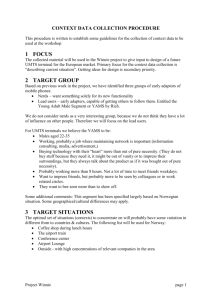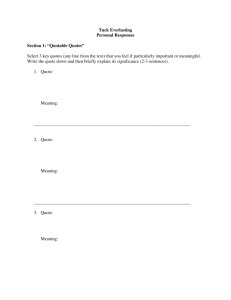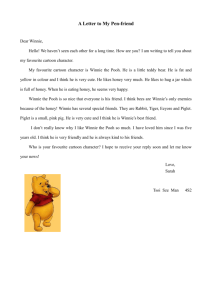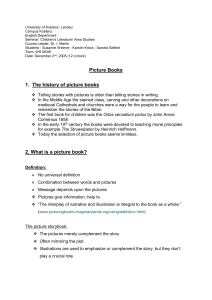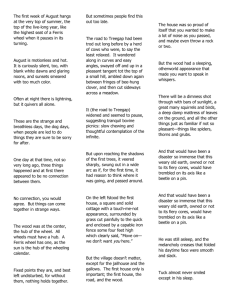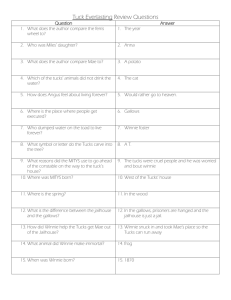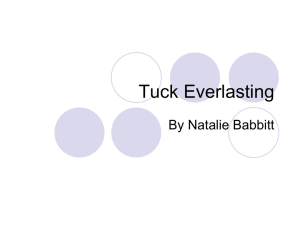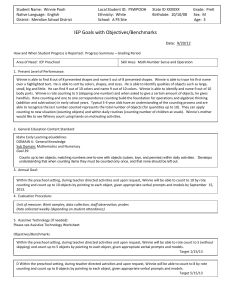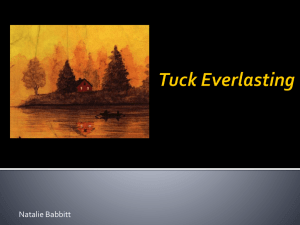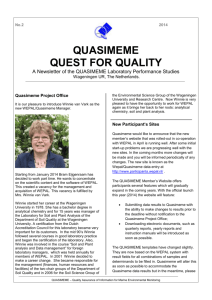Language Arts Unit: Cycles in Nature Timeframe: 8 weeks Grade: 5 1
advertisement
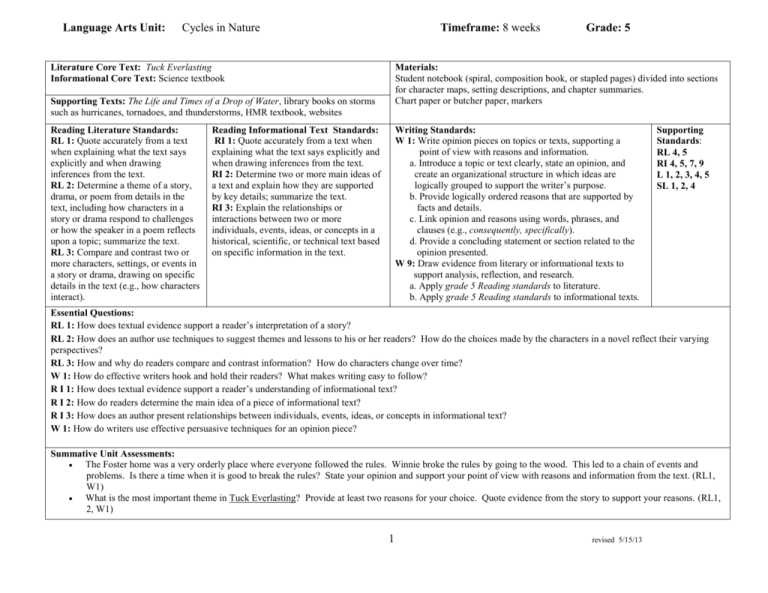
Language Arts Unit: Cycles in Nature Timeframe: 8 weeks Literature Core Text: Tuck Everlasting Informational Core Text: Science textbook Materials: Student notebook (spiral, composition book, or stapled pages) divided into sections for character maps, setting descriptions, and chapter summaries. Chart paper or butcher paper, markers Supporting Texts: The Life and Times of a Drop of Water, library books on storms such as hurricanes, tornadoes, and thunderstorms, HMR textbook, websites Reading Literature Standards: RL 1: Quote accurately from a text when explaining what the text says explicitly and when drawing inferences from the text. RL 2: Determine a theme of a story, drama, or poem from details in the text, including how characters in a story or drama respond to challenges or how the speaker in a poem reflects upon a topic; summarize the text. RL 3: Compare and contrast two or more characters, settings, or events in a story or drama, drawing on specific details in the text (e.g., how characters interact). Grade: 5 Reading Informational Text Standards: Writing Standards: RI 1: Quote accurately from a text when W 1: Write opinion pieces on topics or texts, supporting a explaining what the text says explicitly and point of view with reasons and information. when drawing inferences from the text. a. a. Introduce a topic or text clearly, state an opinion, and RI 2: Determine two or more main ideas of b. create an organizational structure in which ideas are a text and explain how they are supported c. logically grouped to support the writer’s purpose. by key details; summarize the text. d. b. Provide logically ordered reasons that are supported by RI 3: Explain the relationships or e. facts and details. interactions between two or more f. c. Link opinion and reasons using words, phrases, and individuals, events, ideas, or concepts in a g. clauses (e.g., consequently, specifically). historical, scientific, or technical text based h. d. Provide a concluding statement or section related to the on specific information in the text. i. opinion presented. W 9: Draw evidence from literary or informational texts to support analysis, reflection, and research. a. Apply grade 5 Reading standards to literature. b. Apply grade 5 Reading standards to informational texts. Supporting Standards: RL 4, 5 RI 4, 5, 7, 9 L 1, 2, 3, 4, 5 SL 1, 2, 4 Essential Questions: RL 1: How does textual evidence support a reader’s interpretation of a story? RL 2: How does an author use techniques to suggest themes and lessons to his or her readers? How do the choices made by the characters in a novel reflect their varying perspectives? RL 3: How and why do readers compare and contrast information? How do characters change over time? W 1: How do effective writers hook and hold their readers? What makes writing easy to follow? R I 1: How does textual evidence support a reader’s understanding of informational text? R I 2: How do readers determine the main idea of a piece of informational text? R I 3: How does an author present relationships between individuals, events, ideas, or concepts in informational text? W 1: How do writers use effective persuasive techniques for an opinion piece? Summative Unit Assessments: The Foster home was a very orderly place where everyone followed the rules. Winnie broke the rules by going to the wood. This led to a chain of events and problems. Is there a time when it is good to break the rules? State your opinion and support your point of view with reasons and information from the text. (RL1, W1) What is the most important theme in Tuck Everlasting? Provide at least two reasons for your choice. Quote evidence from the story to support your reasons. (RL1, 2, W1) 1 revised 5/15/13 Language Arts Unit: Cycles in Nature Week 1: Learning Targets: Students will quote accurately what the text says explicitly when determining the key details. Students will use details directly from the text to determine two main ideas. Students use details directly from the text to write a summary. Using a graphic organizer, students will use details directly from the text to explain the relationship (or interaction) of two or more concepts in a scientific text. Timeframe: 8 weeks Grade: 5 Standards: RI 1: Quote accurately from a text when explaining what the text says explicitly and when drawing inferences from the text. RI 2: Determine two or more main ideas of a text and explain how they are supported by key details; summarize the text. RI 3: Explain the relationships or interactions between two or more individuals, events, ideas, or concepts in a historical, scientific, or technical text based on specific information in the text. Before beginning the lesson in the Science text, introduce the theme of this unit: CYCLES Define CYCLES as a series of events that are regularly repeated in the same order. Concept Development (see Appendix B for examples) Divide students into groups of 5–6 and give each a large sheet of paper and markers. Post pictures of cycles (see Appendix B) for students to get ideas. Ask the participants to brainstorm everything they can think of about “cycles”. Give them plenty of time and don’t worry about silences. After sufficient time to think and write, ask the students to look at their lists and see if there are ways they can group their comments. Next, have them label each group. Post the labeled groups. Have each group of students share results, allowing them time to explain their reasoning. Ask students to create new groups “Which of the items under one group can also go under another group? Teacher charts. Regroup: “Now which groups can go under another group?” Allow student to work together on this. Ask, “Based on our original list, the groups we’ve created, and the subsumed groups, what can you conclude about cycles?” Allow students time to come up with generalizations about cycles. If they are still struggling after some time, provide an example such as, “Cycles have a specific order.” As a class, find some common generalizations that can be used for the entire class. Theme Scavenger Hunt Building an awareness of the theme is a prerequisite to studying it. Have students bring in pictures, models, quotes, stories, anecdotes, things that make them think of cycles. Post them on a bulletin board. Discuss the why. Cycles Websites http://www.windows2universe.org/earth/climate/cycles_general.html http://www.eo.ucar.edu/kids/green/cycles1.htm Informational Text Structure Science Book Point out and discuss the structure of the text (headings, pictures with captions, diagrams) to discuss their function in understanding the text. How is the text organized? Why? How is the organization and non-print information useful in comprehension? 2 revised 5/15/13 Language Arts Unit: Cycles in Nature Timeframe: 8 weeks Grade: 5 Unit 3: Water on Earth moves from the oceans to the land by the processes of evaporation and condensation. Lesson 1: (Vocabulary: condensation, evaporation, water cycle, water vapor) Discussion Questions What is the main idea? What are the key details to support the main idea? Tasks Read Lesson 1 (student text pages 222-231) Create a main idea/details chart for each heading: The Water Planet; The Water Cycle; Evaporation; Condensation. Quote details from the text to support the main ideas, using quotation marks and page number references. (See Appendix B for examples; graphic organizers in Appendix A) Use graphic organizers/notes to record main ideas and key details in student notebooks. After lesson 1, discuss the Essential Question: How does water move from Earth to the air and back again? Students must provide evidence from the text to support their ideas. Sample frames to use: I know ________ because __________. Based on ____________, I think ________. Assessment: Summarize the water cycle in writing, using key details from the text. Include a diagram. (RI1, 2) Lesson 2: (Vocabulary: watershed, dam, reservoir, aqueduct, groundwater) Discussion Questions What is the main idea? What are the key details to support the main idea? Tasks Read Lesson 2 (student text pages 236-245) Create a main idea/details chart for each heading: Water Resources; Local Water Sources; Groundwater. Quote details from the text to support the main ideas, using quotation marks and page number references. (See Appendix B for examples; graphic organizer Appendix C) Use graphic organizers/notes to record main ideas and key details in student notebooks. After lesson 2, discuss the Essential Question: How do Californians get the water they need? Students must provide evidence from the text to support their ideas. Sample frames to use: I know ________ because __________. Based on ____________, I think ________. Assessment: 1. The Big Idea of science unit 3 is “Water on Earth moves from the oceans to the land by the processes of evaporation and condensation.” Explain the Big Idea using evidence from the text. (RI 1, 2, 3) 2. Looking at the visual summary on p. 262, explain the relationship of the three visuals. How do the pictures support the Big Idea? (RI 2, 3) 3 revised 5/15/13 Language Arts Unit: Cycles in Nature Week 2: Learning Targets: Students will quote accurately what the text says explicitly when determining the key details. Students will use details directly from the text to determine two main ideas. Students use details directly from the text to write a summary. Using a graphic organizer, students will use details directly from the text to explain the relationship (or interaction) of two or more concepts in a scientific text. Timeframe: 8 weeks Grade: 5 Standards: RI 1: Quote accurately from a text when explaining what the text says explicitly and when drawing inferences from the text. RI 2: Determine two or more main ideas of a text and explain how they are supported by key details; summarize the text. RI 3: Explain the relationships or interactions between two or more individuals, events, ideas, or concepts in a historical, scientific, or technical text based on specific information in the text. Science Unit 4: Energy from the sun heats Earth unevenly. This causes air movements that result in changes in the weather. Lesson 1 (Vocabulary: atmosphere, weather, air pressure, convection current, local wind, prevailing wind) Discussion Questions What is the main idea? What are the key details to support the main idea? Tasks Read Lesson 1 (student text pages 268-277) Create a main idea/details chart for each heading: The Atmosphere; Air Pressure; Uneven Heating and Local Winds; Global Winds. Quote details from the text to support the main ideas. (See Appendix B for examples; graphic organizer Appendix C) Use graphic organizers/notes to record main ideas and key details in student notebooks After lesson 1, discuss the Essential Question: How does uneven heating of Earth affect weather? Students must provide evidence from the text to support their ideas. Sample frames to use: I know ________ because __________. Based on ____________, I think ________. Assessment: Using details from the text, describe how local winds, such as sea breezes and land breezes, form. (RI 1, 2, 3) Lesson 2 (Vocabulary: current, humidity, precipitation) Discussion Questions How do the oceans affect weather? What effect does the water cycle have on weather? What causes clouds to form? What causes different types of precipitation? Tasks This section uses a cause and effect structure. Prior to this, the structure in the text was main idea and details. Point out to the students how the authors present the information. Use flow charts to diagram the causes and effects. Read Lesson 2 (student text pages 268-277) Create a cause and effect flow chart for each heading: The Oceans Affect Weather; Weather Patterns and the Water Cycle; Clouds; Precipitation. Quote details from the text to support the causes and effects. (See Appendix B for examples; graphic organizers in Appendix A) Use graphic organizers/notes to record main ideas and key details in student notebooks. After lesson 2, discuss the Essential Question: How do oceans and the water cycle affect weather? Read The Life and Times of a Drop of Water to reinforce concepts. How is this book structured? (cause and effect, main idea and details, sequentially?) Assessment: Using details directly from the text, explain the relationship between weather patterns and the water cycle. (RI 1, 3) 4 revised 5/15/13 Language Arts Unit: Cycles in Nature Timeframe: 8 weeks Week 3: Learning Targets: Students will quote accurately what the text says explicitly when determining the key details. Students will use details directly from the text to determine two main ideas. Using a graphic organizer, students will use details directly from the text to explain the relationship (or interaction) of two or more concepts in a scientific text. Grade: 5 Standards: RI 1: Quote accurately from a text when explaining what the text says explicitly and when drawing inferences from the text. RI 2: Determine two or more main ideas of a text and explain how they are supported by key details; summarize the text. RI 3: Explain the relationships or interactions between two or more individuals, events, ideas, or concepts in a historical, scientific, or technical text based on specific information in the text. Lesson 3 (Vocabulary: meteorology, barometer, anemometer, hygrometer, air mass, front) Discussion Questions What is the main idea of each section? What are the key details to support the main ideas? How does the chart on p.300 help us understand modern weather measurement? How can weather be predicted without instruments? How does the diagram contribute to your understanding of fronts? Why do most weather changes occur along fronts? Why isn’t it possible to predict the weather very far into the future? Tasks Read Lesson 3 (student text pages 296-305) Chart the effects of the four types of air masses. Use the symbols on the map on p. 304 to describe the weather in various areas. Create a main idea/details chart for each heading: Measuring Weather; Air Masses; Fronts; Weather Maps; Forecasting Weather. Quote details from the text to support the main ideas. (See Appendix B for examples; graphic organizers in Appendix A) Use graphic organizers/notes to record main ideas and key details in student notebooks After lesson 3, discuss the Essential Question: How is weather predicted? Students must provide evidence from the text to support their ideas. Sample frames to use: I know ________ because __________. Based on ____________, I think ________. Assessment: Describe how weather forecasts depend on variables such as air masses and fronts. (Use sentence stems as needed.)(RI 2, 3) Lesson 4 (Vocabulary: monsoon, hurricane, thunderstorm, tornado) Discussion Questions What words does the author use to indicate cause and effect relationships? How does the diagram on p.314-315 contribute to your understanding of hurricanes? What information does the diagram on p.316 provide? What information does the photograph on p.317 provide? Tasks This section uses a cause and effect structure. Point out to the students how the authors present the information. Read Lesson 4 (student text pages 308-317) Create a cause and effect flow chart for each heading: Pacific Storms; Hurricanes and Other Cyclones; Thunderstorms and Tornadoes. Quote details from the text to support the causes and effects. (See Appendix B for examples; graphic organizers in Appendix A) 5 revised 5/15/13 Language Arts Unit: Cycles in Nature Timeframe: 8 weeks Grade: 5 Use graphic organizers/notes to record main ideas and key details in student notebooks After lesson 4, discuss the Essential Question: What are the causes and effects of severe weather? Read Teacher Read Aloud from HMR Theme 1 p.53U-X Hurricanes: Weather at its Wildest How is the text organized? Read from HMR Theme 1 p.65-66 under the heading “Storm Seasons and Chasing” to identify cycles of weather patterns. Assessment: Explain the relationship between tornadoes and hurricanes using specific details from the text. (RI 1, 3) 6 revised 5/15/13 Language Arts Unit: Cycles in Nature Week 4: Learning Targets: Students will quote accurately what the text says explicitly when determining the key details. Students will use details directly from the text to write a summary. Compare and contrast two settings in a text, drawing on specific details in the text. Identify how characters in a story or drama respond to challenges. Timeframe: 8 weeks Grade: 5 Standards: RL 1: Quote accurately from a text when explaining what the text says explicitly and when drawing inferences from the text. RL 2: Determine a theme of a story, drama, or poem from details in the text, including how characters in a story or drama respond to challenges or how the speaker in a poem reflects upon a topic; summarize the text. RL 3: Compare and contrast two or more characters, settings, or events in a story or drama, drawing on specific details in the text W 1: Write opinion pieces on topics or texts, supporting a point of view with reasons and information. Theme Review Revisit cycles as done during the first week in the unit. Discuss the different cycles found in nature as well as man-made cycles. Discuss these generalizations about cycles: Cycles may be natural or man-made. Cycles are composed of events that repeat in the same order. Prologue Discussion Questions How does the author introduce the idea of cycles? How does a Ferris wheel represent a calendar? Tasks Describe the three important events that appear unconnected. Start a flow chart for the three events. (See Appendix B.) Figurative Language (find and chart - see Appendix B) Examples: Add “Ferris wheel” to the Symbolism chart. The Ferris wheel symbolizes the circle of life. Foreshadowing – (see Teaching Guide for a mini lesson on foreshadowing) First paragraph – “…when people are led to do things they are sure to be sorry for later.” Last paragraph – “But sometimes people find this out too late.” Chapter One (Vocabulary: oppressive, weary) Discussion Questions Explain what the narrator means by, “Nothing ever seems interesting when it belongs to you—only when it doesn’t.” (See the double entry journal in Appendix B for examples.) Tasks Ironically, the Fosters own the house and the wood. Identify details of the Foster home. Identify details of the wood. At the end of each chapter, students write a few sentences in their notebooks summarizing key details from the chapter. Figurative Language This entire chapter foreshadows events in the book. Discuss the details and their possible meanings. Discuss the personification of the road in the first paragraph. Discuss the personification of the house being proud of itself in paragraph three. Discuss how the metaphor, damp mattress of leaves, helps us picture the wood in paragraph seven. The final paragraph foreshadows the importance of the wood. Discuss why the wood may be so important. 7 revised 5/15/13 Language Arts Unit: Cycles in Nature Timeframe: 8 weeks Grade: 5 Chapter Two (Vocabulary: melancholy) Discussion Questions What does Tuck dream about? What does the dream suggest about Tuck’s attitude toward his life? What does Mae Tuck always have with her? Why? What details can we add to the flow chart? Why is Mae not interested in seeing her reflection? How is that possible? Tasks Students write a few sentences in their notebooks summarizing key details from the chapter. Chapter Three (Vocabulary: suspended, exasperated) Discussion Questions How does Winnie feel about her life? How does the weather reflect her feelings? Explain how Winnie feels when she states, “I’m not exactly sure what I’d do, you know, but something interesting—something that’s all mine. Something that would make some kind of difference in the world.” (See the double entry journal in Appendix B for examples.) What details can we add to the flow chart? How does the toad represent the theme of cycles? Tasks Start character descriptions in student notebooks - Four words which describe Winnie, two important quotes from her, and one paragraph that describes her role. Figurative Language Examples: Add the toad to the Symbolism chart. A toad’s metamorphosis symbolizes Winnie’s upcoming changes in her life. It is another symbol of the circle of life. Students write a few sentences in their notebooks summarizing key details from the chapter. Read “The Other Side of the Door” by Jeff Moss. (see Appendix D) How is the narrator of the poem similar to Winnie’s character? Chapter Four (Vocabulary: suspiciously) Discussion Questions Why does Winnie’s grandmother call her Winifred instead of Winnie? How does this reflect the grandmother’s character? What is your first impression of the man in the yellow suit? What clues does the author give you about this character? (yellow represents cowardice, he won’t give his name, …) What tune is the man in the yellow suit humming? What details can we add to the flow chart? Tasks Connect the three events to the music box. Opinion writing: Why did the author call this character “The man in the yellow suit” instead of a person’s name? Model writing as needed. (See the teaching guide for an example) Students write a few sentences in their notebooks summarizing key details from the chapter. Assessment: Identify the differences between the house and the wood. (RL 3) 8 revised 5/15/13 Language Arts Unit: Cycles in Nature Week 5: Learning Targets: Students state an opinion and group their reasons in a logical way. They use linking words, phrases, and clauses to tie their opinions to their reasons. Compare and contrast two characters in a text, drawing on specific details in the text. Students will use details directly from the text to write a summary. Timeframe: 8 weeks Grade: 5 Standards: RL1 Quote accurately from a text when explaining what the text says explicitly and when drawing inferences from the text. RL2 Determine a theme of a story, drama, or poem from details in the text, including how characters in a story or drama respond to challenges or how the speaker in a poem reflects upon a topic; summarize the text. RL3 Compare and contrast two or more characters, settings, or events in a story or drama, drawing on specific details in the text W1 Write opinion pieces on topics or texts, supporting a point of view with reasons and information. Chapter Five (Vocabulary: disheartened, consolingly) Discussion Questions Why does Winnie change her mind about going into the wood? What details can we add to the flow chart? Describe the woods from Winnie’s perspective. What feeling does she get about the woods? Why do her feelings surprise her? What is Winnie’s first impression of Jesse? What do you think Jesse is thinking when he tries to prevent Winnie from drinking the spring water? Mae says, “Well, boys, here it is. The worst is happening at last.” What do you think she means by this statement? (See the double entry journal in Appendix B for examples.) Tasks In this chapter are several symbols of life and its changes: first is the toad who is there when Winnie takes her first steps into the wood, emphasizing the idea of Winnie’s metamorphosis as she steps beyond the safety she has always known in her own back yard. In addition, the enormous tree with the huge roots symbolizes how the years bring on changes now that it’s grown from a sapling to a huge tree. Connect these symbols to the theme of cycles. Opinion writing: Why does Winnie decide not to run away from home? Figurative Language Examples: Add to Foreshadowing chart. “Well, boys, here it is. The worst is happening at last.” Students write a few sentences in their notebooks summarizing key details from the chapter. Chapter Six Discussion Questions Why do the Tucks kidnap Winnie? Why is the man in the yellow suit following Winnie and the Tucks? What details can we add to the flow chart? What vision has Winnie had about being kidnapped? How does the actual experience differ from her vision? What calms Winnie down when she is upset? Why does it help to calm her? Add the music box to the Symbolism chart. It also can be added to the flow chart. It connects the three events. Tasks (Start tracking the major events in the book and Winnie’s reaction to them, either on a chart or in students’ notebooks.) Figurative Language Examples: Simile - “Her backbone felt like a pipe full of running water.” Simile – “Her mouth went as dry as paper.” Students write a few sentences in their notebooks summarizing key details from the chapter. 9 revised 5/15/13 Language Arts Unit: Cycles in Nature Timeframe: 8 weeks Grade: 5 Chapter Seven (Vocabulary: peculiar) Discussion Questions How does drinking from the spring affect people and animals? How did the Tucks react when they learned of their immortality? How does this relate to the theme of cycles? Tasks Opinion writing: Should the Tuck family have kidnapped Winnie? Figurative Language Simile – “They gathered around her like children at their mother’s knee.” Students write a few sentences in their notebooks summarizing key details from the chapter. Chapter Eight Discussion Questions What is the “plan” for Winnie for the next few days? How does Winnie react to the secret? Who overhears the Tucks’ secret? Given what the author has already told us about this character, what do you think he is up to? How do the actions of this character create suspense, or tension, in the plot? Tasks Character description in the notebook - Four words which describe Jesse, two important quotes from him, and one paragraph which describes his role. Figurative Language Simile – “The sweet earth opened out its wide four corners to her like the petals of a flower ready to be picked.” Students write a few sentences in their notebooks summarizing key details from the chapter. Chapter Nine Discussion Questions How do Mae and Miles take care of Winnie on the trip to their home? How does the reader know that Tuck cares about Winnie? How does Winnie react to arriving at the Tucks’ home? Tasks Figurative Language Simile – “Everything else was motionless, dry as biscuit.” Simile – “Queen Anne’s lace lay dusty on the surface of the meadows, like foam on a painted sea.” Simile – “We’re plain as salt, us Tucks.” Simile - “The whole is going to come apart like wet bread.” Students write a few sentences in their notebooks summarizing key details from the chapter. 10 revised 5/15/13 Language Arts Unit: Cycles in Nature Week 6: Learning Targets: Students state an opinion and group their reasons in a logical way. They use linking words, phrases, and clauses to tie their opinions to their reasons. Compare and contrast two or more characters, settings, or events in a story, drawing on specific details in the text. Students will use details directly from the text to write a summary. Timeframe: 8 weeks Grade: 5 Standards: RL1 Quote accurately from a text when explaining what the text says explicitly and when drawing inferences from the text. RL2 Determine a theme of a story, drama, or poem from details in the text, including how characters in a story or drama respond to challenges or how the speaker in a poem reflects upon a topic; summarize the text. RL3 Compare and contrast two or more characters, settings, or events in a story or drama, drawing on specific details in the text W1 Write opinion pieces on topics or texts, supporting a point of view with reasons and information. Chapter Ten (Vocabulary: perilous, revolutionary, disarray) Discussion Questions How long have the Tucks lived in their home, and why are they thinking of moving? How does this represent a cycle? Why does Mae say, “Life’s got to be lived, no matter how long or short . . . You got to take what comes.” (See the double entry journal in Appendix B for examples.) What advice does Mae give Winnie about living life? Explain how Mae might have come to this conclusion. How do things look for Winnie now? Tasks Compare and contrast the Foster and Tuck homes. (Details on the Foster home were recorded in Chapter one.) Add to the notebook: character description - Four words which describe Mae, two important quotes from her, and one paragraph which describes her role. Students write a few sentences in their notebooks summarizing key details from the chapter. Chapter Eleven Discussion Questions How is supper at the Tuck’s home different from what Winnie is used to? Why does she feel the meal is “luxurious”? Why does she suddenly feel homesick? Why does Tuck insist on talking to Winnie? Students write a few sentences in their notebooks summarizing key details from the chapter. Chapter Twelve (Vocabulary: anguish) Discussion Questions What does Tuck mean when he tells Winnie, “Everything’s a wheel, turning and turning, never stopping?” How is this wheel similar to the Ferris wheel in the Prologue? How does this relate to the theme of cycles? How does Tuck compare the Tuck’s life to the rowboat? Explain what you think Tuck is trying to get across to Winnie. Why doesn’t he want to live forever? Tasks Opinion writing: Why does Tuck not want anyone else to drink from the spring? Add to the notebook: character description - Four words which describe Tuck, two important quotes from him, and one paragraph which describes his role. Figurative Language Simile - “The sky was a ragged blaze of red and pink and orange, and its double trembled on the surface of the pond like color spilled from a paintbox.” 11 revised 5/15/13 Language Arts Unit: Cycles in Nature Timeframe: 8 weeks Grade: 5 Metaphor – “The sun was dropping fast now, a soft red sliding egg yolk.” Simile – “Like a flame of a candle” Simile – “They’d all come running, like pigs to slops.” Students write a few sentences in their notebooks summarizing key details from the chapter. Chapter Thirteen Discussion Questions Why did the man in the yellow suit go to the Foster’s house instead of to the police? What details can we add to the flow chart? Tasks Add to the notebook: character description - Four words which describe the man in the yellow suit, two important quotes from him, and one paragraph which describes his role. Students write a few sentences in their notebooks summarizing key details from the chapter. Chapter Fourteen Discussion Questions How does Winnie feel on her first night away from home? Tasks Figurative Language Idiom – “Stealing their horse right out from under their nose.” Simile – “The cushions of the sofa were remarkably lumpy and smelled like old newspaper.” Metaphor – “The moon rose, turning the pond to silver.” Students write a few sentences in their notebooks summarizing key details from the chapter. Chapter Fifteen (Vocabulary: illiterate) Discussion Questions What does the man in the yellow suit tell the Fosters about the Tucks? What details can we add to the flow chart? What trade does the man in the yellow suit propose to the Fosters? Figurative Language (find and chart) Tasks Students write a few sentences in their notebooks summarizing key details from the chapter. Chapter Sixteen Discussion Questions How does the constable react to the news that the man in the yellow suit brings? What reason does the man in the yellow suit give the constable for wanting to go ahead of him? Do you think he is telling the truth? Why or why not? Tasks Figurative Language (find and chart) Students write a few sentences in their notebooks summarizing key details from the chapter. Assessment: Opinion writing: “Who is more criminal – the man in the yellow suit for what he is doing or the Tucks for kidnapping Winnie?” 12 revised 5/15/13 Language Arts Unit: Cycles in Nature Timeframe: 8 weeks Grade: 5 Week 7: Standards: RL1 Quote accurately from a text when explaining what the text says explicitly and when drawing inferences Learning Targets: Students state an opinion and group their reasons in a from the text. logical way. They use linking words, phrases, and clauses RL2 Determine a theme of a story, drama, or poem from details in the text, including how characters in a story to tie their opinions to their reasons. or drama respond to challenges or how the speaker in a poem reflects upon a topic; summarize the text. Compare and contrast two or more characters, settings, or RL3 Compare and contrast two or more characters, settings, or events in a story or drama, drawing on specific events in a story, drawing on specific details in the text. details in the text Students will use details directly from the text to write a W1 Write opinion pieces on topics or texts, supporting a point of view with reasons and information. summary. Chapter Seventeen Discussion Questions Why didn’t Miles give his wife and children water from the spring? How does Miles disagree with the way his father lives? Why does Winnie tell Miles to put the fish back in the pond? Tasks Character description - Four words which describe Miles, two important quotes from him, and one paragraph which describes his role. Assessment: How do Miles and Jesse’s attitudes differ about drinking from the spring? Figurative Language (find and chart) Students write a few sentences in their notebooks summarizing key details from the chapter. Chapter Eighteen Discussion Questions How does Winnie react when she sees Jesse in the morning? Who is at the Tucks’ door? Figurative Language (find and chart) Chapter Nineteen (Vocabulary - grudgingly) Discussion Questions How did the man in the yellow suit learn about the Tucks? What has he done to pursue the Tucks’ story? What does the man in the yellow suit plan to do with the spring? What do his actions tell you about his character? The narrator says that Mae "swung the shotgun round her heard, like a wheel." Why is this an appropriate simile? How does this relate to the theme of cycles? (See the double entry journal in Appendix B for examples.) Tasks Opinion writing: Do you think Mae does the right thing? Figurative Language (find and chart) Students write a few sentences in their notebooks summarizing key details from the chapter. 13 revised 5/15/13 Language Arts Unit: Cycles in Nature Timeframe: 8 weeks Grade: 5 Chapter Twenty (Vocabulary: unflinchingly) Discussion Questions To protect the Tucks, what does Winnie tell the constable? How does Tuck feel when he stares at the man in the yellow suit? Why? What will happen to Mae if the man in the yellow suit dies? Why are the Tucks horrified by the thought of that happening to Mae? What new possibility does Winnie see before her? Tasks This chapter shows Winnie’s ultimate metamorphosis - she is beginning to think of others before herself. Relate this to the theme of cycles. Figurative Language (find and chart) Students write a few sentences in their notebooks summarizing key details from the chapter. Chapter Twenty-One (Vocabulary - anxiously) Discussion Questions Explain the dilemma about Mae and the man in the yellow suit. How is Winnie different when she returns home? Why can’t the constable press kidnapping charges against the Tucks? Tasks Figurative Language (find and chart) Students write a few sentences in their notebooks summarizing key details from the chapter. Assessment: Compare and contrast two or more characters from the story, drawing on specific details in the text. Start a two-week project: Create a pamphlet teaching elements of literature and literary devices to younger students using illustrations and evidence from Tuck Everlasting. Allow one page for each element or device and give its definition under the heading. Include two devices from the following list: simile, metaphor, symbolism, and imagery. In addition, include these three elements: theme, setting, and character development. 14 revised 5/15/13 Language Arts Unit: Cycles in Nature Timeframe: 8 weeks Grade: 5 Week 8: Standards: RL1 Quote accurately from a text when explaining what the text says explicitly and when drawing inferences Learning Targets: Students state an opinion and group their reasons in a from the text. logical way. They use linking words, phrases, and clauses RL2 Determine a theme of a story, drama, or poem from details in the text, including how characters in a to tie their opinions to their reasons. story or drama respond to challenges or how the speaker in a poem reflects upon a topic; summarize the text. Compare and contrast two or more characters, settings, or RL3 Compare and contrast two or more characters, settings, or events in a story or drama, drawing on specific events in a story, drawing on specific details in the text. details in the text Students will use details directly from the text to write a W1 Write opinion pieces on topics or texts, supporting a point of view with reasons and information. summary. Chapter Twenty-Two Discussion Questions Who unexpectedly visits Winnie at the fence? Why did he come there? How are Jesse, Miles, and Tuck planning to help Mae escape from jail? Why does Winnie offer to help the Tucks? Opinion writing: Is Jesse being selfish when he gives Winnie the bottle of spring water? Tasks In Chapters 22–24, the author uses descriptions of the weather to emphasize the dramatic events that occur as well as the dramatic inner changes in Winnie’s character. Discuss and chart these descriptions. Students write a few sentences in their notebooks summarizing key details from the chapter. Figurative Language (find and chart) Assessment - Opinion writing: “Will Winnie drink the water when she turns seventeen?” Chapter Twenty-Three Discussion Questions What does the author mean when she says, “Winnie had her own strong sense of rightness.”? Why is it important to know what is right and wrong? Why is it so important for Winnie to change places with Mae even though she knows that there could be consequences? What factors came together to lead to the solution of the problem? Tasks Figurative Language (find and chart) Students write a few sentences in their notebooks summarizing key details from the chapter. Chapter Twenty-Four Discussion Questions Why does Winnie repeatedly say the poem, “Stone walls do not a prison make, Nor iron bars a cage,” to herself? (metaphor for the Tuck’s life) What does Jesse say to Winnie before he leaves? Why does he say this? What conclusions can you come to about the main characters? How did their environment and experiences shape their actions? Support your beliefs with examples from the story. Figurative Language (find and chart) Students write a few sentences in their notebooks summarizing key details from the chapter. 15 revised 5/15/13 Language Arts Unit: Cycles in Nature Timeframe: 8 weeks Grade: 5 Chapter Twenty-Five (Vocabulary - unwittingly, wistful, staunchly) Discussion Questions How do the Fosters react to Winnie being an accomplice to the Tuck’s escape? How do the other children in Treegap react to Winnie’s crime? What does Winnie do for the toad? Why does she do it? How did Winnie change over the course of the story? Why do you think she changed in that way? Tasks Figurative Language (find and chart) Students write a few sentences in their notebooks summarizing key details from the chapter. Epilogue Discussion Questions What has changed in Treegap since the Tucks last visited the village? How much time do you think has passed? What happened to the tree and the spring? How does the tree reflect a cycle – the circle of life? Why does Angus Tuck say, “Good girl,” when he sees Winnie’s grave? Did Winnie drink from the spring? What was her ultimate fate and how old was she when it happened? Tasks Refer back to chapter five and the symbol of the tree. Discuss the theme of cycles; the tree has completed its cycle. Summative Assessment: The Foster home was a very orderly place where everyone followed the rules. Winnie broke the rules by going to the wood. This led to a chain of events and problems. Is there a time when it is good to break the rules? State your opinion and support your point of view with reasons and information from the text. (RL1, W1) What is the most important theme in Tuck Everlasting? Provide at least two reasons for your choice. Quote evidence from the story to support your reasons. . (RL1, 2, W1) 16 revised 5/15/13
